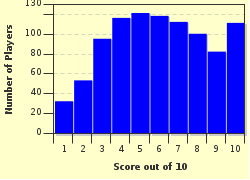Quiz Answer Key and Fun Facts
1. The "center of mass" is a powerful concept for understanding the way that complicated objects move, hugely simplifying calculations of momentum and force. How do you calculate the center of mass of a group of objects?
2. If you're keeping "current" with electrodynamics, you are no doubt familiar with the concept of "charge." An intrinsic quality of matter, it gives rise to electromagnetic forces -- including those that hold your body together and keep your computer running. Let's consider particles that can exist as free particles in nature. What is the smallest non-zero amount of charge that such a particle can carry?
3. "Constants" -- parameters whose values do not change -- are crucial tools in any physics calculation, and the constant "c" is one of the most commonly used of the lot. What physical constant does c represent?
4. The "cosmic microwave background" is a small signal, associated with a temperature of only 2.7 degrees Celsius above absolute zero -- but it has huge implications. What theory of astrophysics does this background radiation support?
5. If you ever need to calculate the force between two stationary electrical charges, you can't go wrong with "Coulomb's law." It turns out that the electrical force depends not only on the amount of charge carried by the two objects, but also on the distance between those objects. How does it depend on the distance?
6. Here's a term representing a simple mathematical operation that underlies powerful physics -- from angular momentum to the force exerted by a magnetic field. By this method, we can combine two vectors to find a third that's perpendicular to both of them -- but we have to watch out for the right-hand rule. What is this operation, also called the vector product?
7. The "Chandrasekhar limit" is one of the more dramatic terms of physics, dealing with events at the end of a star's life. Very old stars tend to collapse into white dwarf stars, but not all of them end that way. White dwarf stars have a maximum mass -- the Chandrasekhar limit -- and collapsing stars more massive than that must end up as a neutron star, a black hole, or a supernova explosion. What is the value of the Chandrasekhar limit?
8. Objects in uniform "circular" motion travel at a constant speed, but their velocity is always changing direction to keep them moving along a circular path. We can calculate the acceleration of such an object as v^2/r, where v is the magnitude of the object's velocity and r is the radius of its circular path. How do we refer to a force that produces such an acceleration?
9. Sooner or later, every student of gravity is confronted with the fact that this force is "conservative." Fear not, however: we aren't really going to inject politics into physics! What do we mean when we say that a force like gravity is conservative?
10. Whew! After nine words and phrases, I'm just about ready to collapse -- which reminds me of yet another important phrase. In quantum mechanics, we often speak of the "collapse of a wave function," a moment in which probability gives way to certainty and the universe is forced to make a choice. Under what circumstances is a wave function said to collapse?
Source: Author
CellarDoor
This quiz was reviewed by FunTrivia editor
crisw before going online.
Any errors found in FunTrivia content are routinely corrected through our feedback system.

